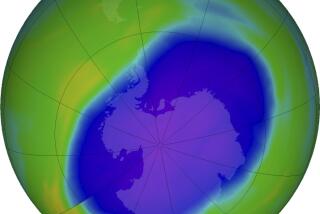It’s Never Too Soon to Halt Use of CFCs
- Share via
I suppose it is not surprising that “Flouting the Ozone Doomsayers, One Scientist Is Flying Close to the Sun” (March 15) by columnist Lee Dye was located in the business section, because businessmen and women prefer to think of profits before the environment.
The omission of the fact that it takes 10 years for CFCs released at ground level to reach ozone destroying altitude, as well as the omission of automobile air conditioners and electronics manufacturing sources of CFCs, point to a business bias in this article. In the research I have done, I found that the scientists claiming damage caused by CFCs is overstated or exaggerated were for the most part working for companies with a vested interest in CFCs continued manufacture and use.
The ozone depletion is real and is taking place worldwide. It is just more pronounced above Antarctica. The 10-year delay between the release and the damage suggests that we don’t have the luxury of waiting to confirm beyond any possible doubt if CFCs will completely or only partially destroy the ozone layer and therefore the planet.
In the stratosphere, one chlorine atom destroys 10,000 ozone molecules. If the ozone layer is destroyed, plant life will suffer terribly. Crops will perish as well as all the animals which feed upon them. What will we eat? Even if the world phased out the manufacture of CFCs, as dictated by timetable of the Montreal Protocol, it will be decades before all the damage has occurred.
Under the protocol, Third World nations would be allowed to continue manufacturing CFCs years after the developed world stopped. And how many front end car accidents with air conditioners or junked refrigerators will contribute well past any CFC production cessation? Is the Montreal Protocol “Draconian” or too little too late? If there is no problem with CFCs, we can always reintroduce their use. No one knows how to recreate the ozone layer.
BRIAN SCHWARZMANN
Rolling Hills Estates
More to Read
Inside the business of entertainment
The Wide Shot brings you news, analysis and insights on everything from streaming wars to production — and what it all means for the future.
You may occasionally receive promotional content from the Los Angeles Times.









